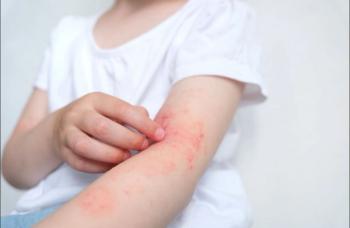
Zosteriform Lentiginous Nevus
A 17-year-old girl sought evaluation of multiple face and neck nevi. The lesions had been present at birth and were becoming darker as the teen grew older. She reported no family or personal history of skin cancer or dysplastic nevi.
A 17-year-old girl sought evaluation of multiple face and neck nevi. The lesions had been present at birth and were becoming darker as the teen grew older. She reported no family or personal history of skin cancer or dysplastic nevi.
Multiple dark brown lesions were noted on an area of faintly tan-colored skin. The 1- to 4-mm macules were located in the C2 to C4 dermatome distribution of the right face and neck. Drs Kathleen B. Elmer, MAJ, USAF, MC, FS, of Yokota Air Base, Japan, and Rita M. George, MAJ, USAF, MC, FS, of Langley Air Force Base, Va, diagnosed the eruption as zosteriform lentiginous nevus, an infrequently reported condition that typically presents with this pattern of involvement.1,2
Speckled lentiginous nevus, or nevus spilus, is composed of dark brown macules overlaying a light brown patch. Histologically, the background patch is a lentigo simplex. The darker, speckled areas represent compound, or junctional, nevi. Zosteriform lentiginous nevus is defined as speckled lentiginous nevus in a dermatomal distribution.3
These lesions are considered benign, and they are not associated with systemic abnormalities. However, cases of malignant melanoma arising in zosteriform lentiginous nevus have been reported.4,5 (The origin of the melanoma-whether in the dark brown macules or the tan background patch-has not been determined.) Thus, these lesions need to be monitored for malignant transformation.
Laser therapy, bleaching creams, and makeup can be used if cosmetic appearance is a concern.
It was once thought that patients with this skin disorder had a greater risk than unaffected persons of neurologic and psychiatric problems, including mental deficiency and atrophy of an involved extremity. Current evidence, however, does not support this theory.6,7
References:
REFERENCES:
1.
Prichett RM, Prichett PS. Zosteriform speckled lentiginous nevus with giant melanosomes.
Cutis.
1982;30:329-334.
2.
Simoes GA. Speckled zosteriform lentiginous nevus.
J Am Acad Dermatol.
1981;4:236-238.
3.
Altman DA, Banse L. Zosteriform speckled lentiginous nevus.
J Am Acad Dermatol.
1992;27:106-108.
4.
Stern JB, Haupt HM, Aaronson CM. Malignant melanoma in a speckled zosteriform lentiginous nevus.
Int J Dermatol.
1990;29:583-584.
5.
Bolognia JL. Fatal melanoma arising in a zosteriform speckled lentiginous nevus.
Arch Dermatol.
1991;127:1240-1241.
6.
RuthWK, Shelburne JD, Jegasothy BV. Zosteriform lentiginous nevus.
Arch Dermatol.
1980;116:478.
7.
Port M, Courniotes J, Podwal M. Zosteriform lentiginous naevus with ipsilateral rigid cavus foot.
Br J Dermatol.
1978;98:693-698.
Newsletter
Enhance your clinical practice with the Patient Care newsletter, offering the latest evidence-based guidelines, diagnostic insights, and treatment strategies for primary care physicians.



























































































































































































































































































